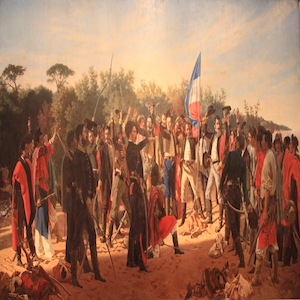South America

Juan de Betanzos, Narrative of the Incas
This extract comes from Juan de Betanzos’ Narrative of the Incas, which was written in the sixteenth century but not published until 1880. Betanzos (1510-1576) was among the early conquistadors, and served as a military leader and official.

Brazilian Carriage
This horse-drawn carriage dates from the late-eighteenth or early nineteenth century. During this period, carriages like this were the preferred form of transportation for elite members of society.

Parque Lage
The Parque Lage is located in the heart of Rio de Janeiro, and at the foot of the Christ the Redeemer mountain. The site features lush gardens and a nineteenth-century mansion. Its name originates from the former residents of the home, Henrique Lage and Gabriella Besanzoni.

First Sounds of the Hymn of Independence
The nation of Brazil declared its independence from Portugal on September 7, 1822 after three centuries of colonial rule. At this time, Brazil was ruled by Emperor Pedro I (1822-1831).

The 33 Orientales
In 1825, Uruguayan troops won their independence from Brazil. The military contingent became known as the “33 Orientales,” reflecting the number of participants and referencing the name of the region (Oriente).

Portón de Campo
This stone structure, also known as the Puerta de la Ciudadela, belonged to the historic defensive walls of Colonia del Sacramento. Although the city is located in modern-day Uruguay, at the time of construction (1745), it was occupied by the Portuguese under Governor Vasconcellos.

Eighteenth-Century Uruguayan Home
On display here are several objects from the Museo Casa de Nacarello, a small museum in Colonia, Uruguay that aims to recreate daily life in an eighteenth-century home.

Castillo de Piria
This castle-like home once belonged to Francisco Piria, a Uruguayan entrepreneur and the founder of the town of Piriápolis. He lived from 1847 to 1933. Piria was the child of Italian immigrants, who comprised a major portion of the population in the Rio de la Plata region during this period.

Ruins of the Convento de San Francisco
These structures are all that remain from a convent built near the coast of modern-day Uruguay in the 1690s. It is located in Colonia del Sacramento, a city that switched back and forth from Spanish rule to Portuguese rule several times during the seventeenth through the nineteenth centuries.

Wooden Triptych
This small wooden piece was constructed as a triptych, with two side panels that can fold over the main panel. It displays religious imagery, with the Virgin Mary at the center. The time period is unclear.